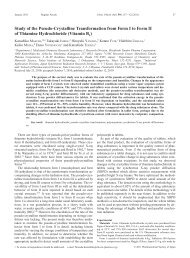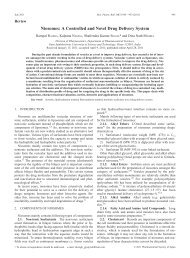High-Frequency Genetic Contents Variations in Clinical
High-Frequency Genetic Contents Variations in Clinical
High-Frequency Genetic Contents Variations in Clinical
Create successful ePaper yourself
Turn your PDF publications into a flip-book with our unique Google optimized e-Paper software.
May 2011 629<br />
Table 5. Comparsion of Retrotransposon Copy Numbers between Control and Test Isolates as Revealed by Array CGH<br />
Retrotransposon Orf<br />
(orf19.111). A total of four genes RIM9, orf19.102; KAR5,<br />
and orf19.104 encode prote<strong>in</strong>s with unknown functions and<br />
the rest four genes are annotated with molecular functions:<br />
HAL22 is a putative phosphoadenos<strong>in</strong>e-5-phosphate (PAP)<br />
or 3-phosphoadenos<strong>in</strong>e 5-phosphosulfate (PAPS) phosphatase;<br />
orf19.107 is an RNA helicase; orf19.109 is an<br />
tyros<strong>in</strong>-tRNA ligase; while CAN2 is an arg<strong>in</strong><strong>in</strong>e transmembrane<br />
transporter. Consensus FDRs was less than 0.001 for<br />
this region. qPCR confirmed the copy number variations of<br />
the above genes (Table 4).<br />
Functional Analysis of Genes with Copy Number <strong>Variations</strong><br />
We attempted to analyze the molecular functions of<br />
158 annotated genes that were shared between at least two<br />
isolates, with the Gene Onthology (GO) Term F<strong>in</strong>der, as well<br />
as with GO Slim Mapper. Both tools are provided by the<br />
Candida Genome Database (CGD). Go Term F<strong>in</strong>der searches<br />
for GO terms significantly shared by the query genes. The<br />
p-value was set to be 0.1. GO Slim Mapper maps annotations<br />
of a group of genes to more general terms and/or b<strong>in</strong>s<br />
them <strong>in</strong>to broad categories. We used chi-square test for significance<br />
analysis of the GO Slim Mapper result. For Go<br />
Term F<strong>in</strong>der, the query set was the 158 variable genes with<br />
annotations of molecular functions, and the background set<br />
of genes was specified as the total of C. albicans genes annotated<br />
with molecular functions, exclud<strong>in</strong>g genes with unknown<br />
function. We found no enrichment <strong>in</strong> any functional<br />
category with the two tools.<br />
Aneuploidy of an Entire Chromosome or a Large Portion<br />
of Chromosome Array CGH unambiguously revealed<br />
chromosomal aneuploidy <strong>in</strong> two isolates: the duplication of<br />
an entire chromosome 1 <strong>in</strong> S197 and the loss of an approximately<br />
55 kb portion of chromosome R <strong>in</strong> S241, as presented<br />
<strong>in</strong> Fig. 3. The segmental aneuploidy <strong>in</strong> S241 extended from<br />
479692 to 535105 bp encompass<strong>in</strong>g a total of twenty genes.<br />
One gene, orf19.3746, was excluded from array CGH analysis<br />
because of the bad hybridization efficiency of genomic<br />
DNA from both SC5314 and S241 with the probes on the microarray.<br />
Ratios (S241/SC5314) of three genes, orf19.3749,<br />
orf19.3735, and orf19.3734, were approximately 1.0, thus,<br />
imply<strong>in</strong>g no change of the DNA amounts. A simple explanation<br />
of this result is the translocation of these genes on the<br />
other chromosome(s). Ratios of the rema<strong>in</strong><strong>in</strong>g sixteen genes<br />
were approximately 0.5, which <strong>in</strong>dicated the loss of one<br />
copy.<br />
In addition, we found that the MTLa locus on chromosome<br />
5 that spans approximately 9 kb is homozygous <strong>in</strong> S727. Although<br />
our microarrays lacked the probes represent<strong>in</strong>g the<br />
OBPa, PIKa, PAPa, and MTLa2 genes from the MTLa<br />
locus, we used PCR approach to amplify these genes from<br />
both MTL loci from the same batch of genomic DNA, which<br />
we used for array CGH. We found MTLa, but no MTLa<br />
locus (Fig. 4A, Table 6). Furthermore, we used qPCR to confirm<br />
that the MTLa locus is present <strong>in</strong> two copies (Fig. 4B,<br />
Table 3). Future research is needed to establish if the entire<br />
chromosome 5 or, alternatively, one copy of MTL was lost<br />
and subsequently duplicated.<br />
DISCUSSION<br />
Ratio (test/control)<br />
P546 U885 F32 S241 S904 S204 S197 S727<br />
Zorro2(0.017 a) ) Orf19.7274 0.94 1.41 1.25 1.03 1.42 1.68 0.88 1.47<br />
Orf19.7275 1.12 1.23 1.54 1.02 1.44 1.65 0.80 1.66<br />
Zorro3(0.19) Orf19.559 1.04 1.06 1.32 1.09 0.92 1.11 1.05 3.30<br />
Tca2(1.2E-06) Orf19.2371 0.01 0.46 0.97 0.36 1.00 0.52 0.01 0.48<br />
Orf19.2372 0.03 0.46 1.34 0.36 1.80 0.46 0.02 0.42<br />
Tca3(5.1E-05) Orf19.2219 0.42 0.68 0.30 0.41 0.39 0.80 0.25 0.86<br />
Tca8 (5.12E-05) Orf19.6078 0.42 0.39 0.58 0.97 0.30 0.33 0.75 0.81<br />
Orf19.6079 0.29 0.34 0.29 0.91 0.28 0.32 0.81 0.81<br />
Tca17(1) Orf19.6807 1.01 0.98 0.94 0.96 0.98 0.95 0.97 0.97<br />
Tca4(0.0016) Orf19.2668 0.10 0.10 0.07 0.97 1.89 1.03 1.00 0.93<br />
Orf19.2669 0.10 0.10 0.06 0.96 1.90 1.02 1.08 1.03<br />
Tca11(1.2E-06) Orf19.6469 0.26 0.53 0.22 1.59 1.08 0.49 0.12 1.20<br />
a) Consensus FDR across all the test samples.<br />
Fig. 3. Segmental Loss on Chromosome R <strong>in</strong> Isolate S241<br />
Panel A: Each row corresponds to a specific spot (gene) on the microarray. The genes<br />
are arranged accord<strong>in</strong>g to their chromosomal coord<strong>in</strong>ates on chromosome R. Each column<br />
corresponds to a test isolate. The status of each gene is <strong>in</strong>dicated as follows: black,<br />
present; red, amplified; green, absent. The hybridization ratios are <strong>in</strong> logarithmic scale.<br />
Panel B presents the systemic names and array CGH profiles of these genes.<br />
The extent of genomic variation with<strong>in</strong> a species is




